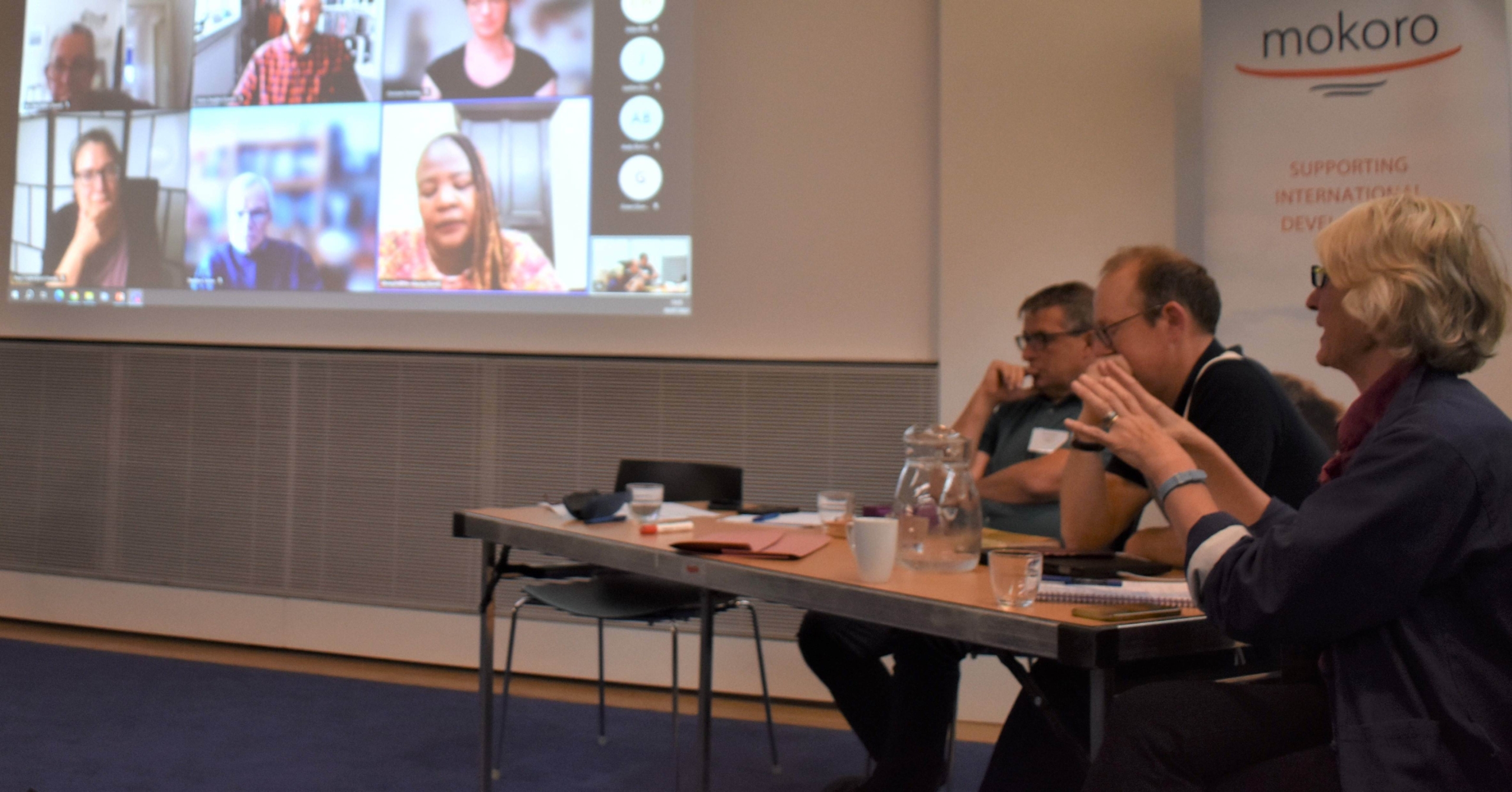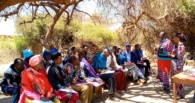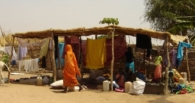Tracking rural communities since 1994
Evidence from EthiopiaWIDE: A Mokoro Seminar – Tuesday, 1 November 2016
Christine Berger
26 January 2017
/
- 0 Comments
Ethiopia. Africa’s oldest independent country. Africa’s second largest in terms of population. A country that has never formally been colonised. The home of one of the oldest Christian churches. A country that has fascinated many with its unique cultural heritage.
Ethiopia faces challenges on many fronts, in education, water and sanitation, health, nutrition and poverty, which are exacerbated by climate shocks and natural disasters. Notwithstanding all the difficulties, Ethiopia has made significant progress towards development over the last two decades, also labelled as “Ethiopia’s Great Run” towards development (WB, 2016).
At the Mokoro seminar on November 1st 2016, chaired by Bev Jones, three members of the Ethiopia WIDE team[1] – Catherine Dom, Pip Bevan and Sarah Vaughan – presented research conducted over a timespan of twenty years, exploring the dynamics and diversity of long-term change in different types of rural communities in Ethiopia. Evidence was collected through a longitudinal, qualitative, case-based study of twenty rural communities between 1994 and 2013 (see http://EthiopiaWIDE.net/). Findings from the WIDE research are also shared with and provide a valuable resource to policy makers and practitioners in Ethiopia.
The team presented selected findings from their most recent analyses in two parts. The first part focussed on changes in the communities as places and as differentiated societies, and what these changes mean for young Ethiopians. The second part explored changes in livelihood opportunities, as well as changes in maternal and infant wellbeing.
Changes in the communities as places, as differentiated societies, and for young people
Significant country-wide changes have had an impact on the trajectories of rural communities in Ethiopia. Noticeable economic progress started in 1992 and accelerated further from 2004, with real annual GDP growth averaging 4.5 percent between 1993 and 2004 and increasing to 10.9 percent between 2004 and 2014 (WB, 2016). This happened shortly after a change in the political landscape, when the military and socialist Derg regime (in power from 1974) was overthrown by rebel factions led by Tigrayans in 1991. The Ethiopian People’s Revolutionary Democratic Front (EPRDF) then introduced a series of economic reforms during the 1990s. Major administrative changes took place in 1995, when multinational federalism was introduced, and in 2002, with the start of district-level decentralisation.
Starting around 2002/2003, Ethiopia entered a period of rapid modernisation. The population grew in numbers, life expectancy increased, and generally people were healthier, better fed, and more educated, with higher aspirations than before. According to the latest Ethiopia Demographic and Health Survey (EDHS 2016) under-five mortality (deaths per 1,000 live births), was halved between 2000 and 2011 (from 166 to 88), and further decreased to 67 in 2016. The same trend has been observed for infant (under 12 months) mortality, which dropped from 97 to 48 per 1,000 live births in the same period.
Between 2003 and 2013 rural communities were more and more connected with the ‘outside’ world, both on a national and on an international level through increased urbanisation and (national and international) migration. The road network improved (though many internal roads are still dry-season only), mobile phone network coverage was extended, radio and (satellite) TV introduced new ideas in politics, development, religion etc. The Government introduced policies/strategies which penetrated rural communities in all areas of life and thereby started to affect local dynamics. These were reflected in a succession of national development plans as follows:
- the first donor-supported Sustainable Development and Poverty Reduction Strategy Paper (SDPRP) (2002/3 – 2004/5),
- the successor Plan for Accelerated and Sustained Development to End Poverty (PASDEP) (2004/5 – 2009/10), and
- the first Growth and Transformation Plan (GTP) (2010/11 – 2014/15), which outlined the goal of attaining middle income country status by 2025, and was then followed by a second GTP (2015/16-2019/20).
The research team found that the WIDE communities were experiencing accelerated urbanisation processes of three different types: ‘rurbanisation’, i.e. expansion of ‘urban-like’ infrastructure (e.g. school, health post, administrative offices) and growth around kebele[2] centres and along roads; urban expansion into rural kebeles from outside; and thickening rural-urban linkages. By 2010-2013, all communities were considerably less rural than in 1994/5 and even 2003. The Government, rural residents and private entrepreneurs were all involved in the development of these new urbanising spaces.
The changing rural-urban dynamics were found to contribute to changes inside these rural communities as well. However, experiences and aspiration in the urbanisation process varied between different groups within the community (female/male, elderly/adults/youth/children, rich/poor). While all communities were affected in some way by the changes in rural landscapes, the biggest barriers to benefitting from urbanisation were found to be remoteness and poverty, a theme that ran through the discussion like a thread.
The team also looked in detail at youth transitions into adulthood, in terms of personal, social and community transitions,[3] and found that local concepts and practices have strong customary economic, social and cultural rationales which are not often considered (enough) by policy makers.
While traditionally youth are thought of in relation to work transitions for young men and in terms of personal and family transitions for young women, the changes that have been taking place over the past two decades necessitate a more balanced attention to young women’s productive roles and young men’s reproductive roles. Cultural rationales and diversity need to be taken into account and more holistic interventions implemented that recognise the links between the different types of transition, e.g. marriage and economic independence for young couples seeking to establish themselves.
Issues such as female circumcision, rape, forced abduction of girls for marriage purposes, early marriage, and pregnancy outside marriage were discussed. The WIDE evidence suggests that despite the progress that has been made in addressing these issues, further progress requires continued intervention. Some legislation is in place, e.g. the National Adolescent and Youth Reproductive Health Strategy 2007–2015. However, very little evidence was found of actual interventions that help victims of rape or forced abduction, for example. Furthermore, while modernisation in many places has reduced parental control over teenage daughters and in a sense given them more freedom, it has also contributed to new or increased risks for girls in many communities, e.g. pregnancy outside marriage and associated taboos leading to potentially harmful customary abortions.
In terms of education, Ethiopia has made significant progress: there has been a tremendous increase in the number of children going to school. However, this has brought new challenges that now need to be addressed, including ensuring quality of education, and greater inclusiveness, which requires more attention to the poor and the vulnerable and to girls and young women. Increased education also brings with it the challenge of many ‘educated’ youth with very few job prospects in rural areas, leading to the conclusion that the education system needs to be further adapted to Ethiopia’s socio-economic context.
In various areas, from work opportunities to education and health, findings show repeatedly that along with modernisation and development there has been increasing inequality, both between communities, with remote communities especially at a disadvantage, and within communities between wealth groups. The WIDE findings also suggest the need for more integrated approaches in policy making, with consideration of local cultural, social and economic norms, to meet the needs of very diverse population groups.
Changes in livelihood opportunities
In 2013 (before El Niño) economic growth and more diversified economies were found in all communities, even in more vulnerable sites. Women were participating more in economic activities, some community members had become successful economically, and migration provided a new economic opportunity.
Over the course of the last two decades, women’s opportunities to participate in the farm and non-farm sectors have notably increased. However, significant gaps remain. Notably, agricultural interventions often bypass women, especially wives; there are often no or very few specific opportunities for women and girls; and there is a lack of support for non- or off-farm activities.
Between 2010 and 2013 more diverse and complex local economies were observed in the communities, which seem to be a result of a synergy of government action, broader contextual changes, and personal initiative and drive, as well as access to capital (land/labour, financial capital, and social capital). The development of infrastructure and increased urbanisation has had a significant impact on the local economies. Diversification built on growth in the farming sector with the success of individual farmers has also had a positive effect on local trade or transport businesses, for example.
With rural development comes an increase in mobility. Migration has become more complex as more women and youth move to seek work. Successful migration was found to have considerable positive effects on communities and individuals in increasing wellbeing, strengthening social protection, intensifying rural-urban links, economic diversification etc. On the other hand, migration also carries a whole array of risks with it. Urban migration often entails a precarious life and small returns or exploitation, especially of women in domestic or hospitality work. Migration abroad is still a difficult issue, with strict legal constraints pushing many into irregular, riskier migration experiences. There is also a gender aspect due to the type of jobs available. Until the end of 2013 (and indications are that it should become possible again) women could work abroad legally as domestic servants. Young men, on the other hand, do not have this opportunity – they are legally blocked from working abroad.
The WIDE team found evidence that well-managed rural migration could contribute to rural development as well as to the Government’s economic transformation goal, and suggested consideration of strengthening migration management capacity through clear policy and research. Furthermore, evidence suggests that national and international migration is likely to continue to increase with rural development, which emphasises the importance of improving migration experiences: better information on and preparation for available jobs, enhanced migration management, strengthening and enforcing of legal frameworks, paying special attention to women’s participation in migration (e.g. working conditions), expanding legal opportunities abroad for young men, etc.
Wellbeing of mothers and infants
Significant improvements in the health and wellbeing of mothers and infants have been observed in rural communities since 2003, resulting from a range of interacting modernisation processes related to government intervention across key sectors. However, mothers and their babies are particularly at risk when living in remote areas without easy access to ante- and post-natal care, when living in poverty, and specifically during droughts. The findings from 2010-2013 show that poor pregnant women and mothers in remote places who are often on inadequate diets do heavy work and do not use health services because they live a long way from health centres, which may have a lack of instruments, and there may be rude service at these centres. Inadequate supply of skilled delivery and expensive obstetric services at health facilities, combined with remoteness, poverty and personal choice will likely continue to prevent many pregnant women delivering at health centres and hospitals for the foreseeable future.
The team concluded that the state should take full responsibility for the health and wellbeing of all women and their infants throughout the pregnancy-infancy cycle. It was suggested that institutionalised maternity rights for women should include ante- and post-natal care as near their home as possible, a choice of place of delivery if there are no complications, free skilled delivery and care for all those identified as at risk or suffering an emergency during labour, and an advisory period of ‘maternity leave’ linked to general community education about pregnant and lactating women’s needs related to diet, drinking water, workloads, lifting heavy objects, and rest. Again, the needs of different kinds of rural communities depending on the terrain, settlement pattern and urban proximity should be taken into account.
Policy themes
Out of the two decades of research, three main policy themes emerged: growth, poverty, and inequalities; change over time and space; and gender-age and experiences of change. Firstly, WIDE evidence showed the importance of agriculture in local economic growth, but also the need for diversification into non-farm activities. It also showed that certain groups of people are trapped in poverty and marginalised economically, demonstrating the need for more (innovative) interventions specifically tailored to the poor and vulnerable. Secondly, change is inevitable and often beneficial; however, rural remoteness, including within communities, is often overlooked in policy and needs to be addressed. Thirdly, the data collected suggest mixed progress in terms of gender equality, and longer, more complex transitions of youth to adulthood. Interventions therefore need to think holistically about gender-age specific needs, potentials and constraints.
Results gleaned from WIDE research show the value of the current standardized, hierarchical and disciplined government approach to policy implementation, but also its limits. Research points towards the value of a more holistic approach to policy, the importance of taking into account the diverse needs of communities and their individual members, the importance of the local context and knowledge, as well as the importance of allowing space for innovative non-conventional ideas, working with broad coalitions of various actors, and the value of more modest but realistic ambitions in implementation.
What next?
Following the presentations there was a lively discussion on implications for policy implementation and the design of interventions in Ethiopia and more widely, as well as on the nature of WIDE engagement with the Government of Ethiopia.
What is next for WIDE? In the short term, a book publication in January 2017 will make the findings available to a wider audience. Longer term, it is hoped that funding will be available for a fourth round of WIDE research so that change in these rural communities, and in some additional ones, can be tracked further.
[1] Alula Pankhurst was not able to be there.
[2] A kebele is the smallest administrative unit in Ethiopia, with all three branches of government.
[3] Personal transitions include puberty, circumcision, sexual, work skills, end of formal education, personal identity; social transitions relate to family and work; community transitions have to do with social network responsibility, organisational participation and local citizenship.
You must be logged in to post a comment.



